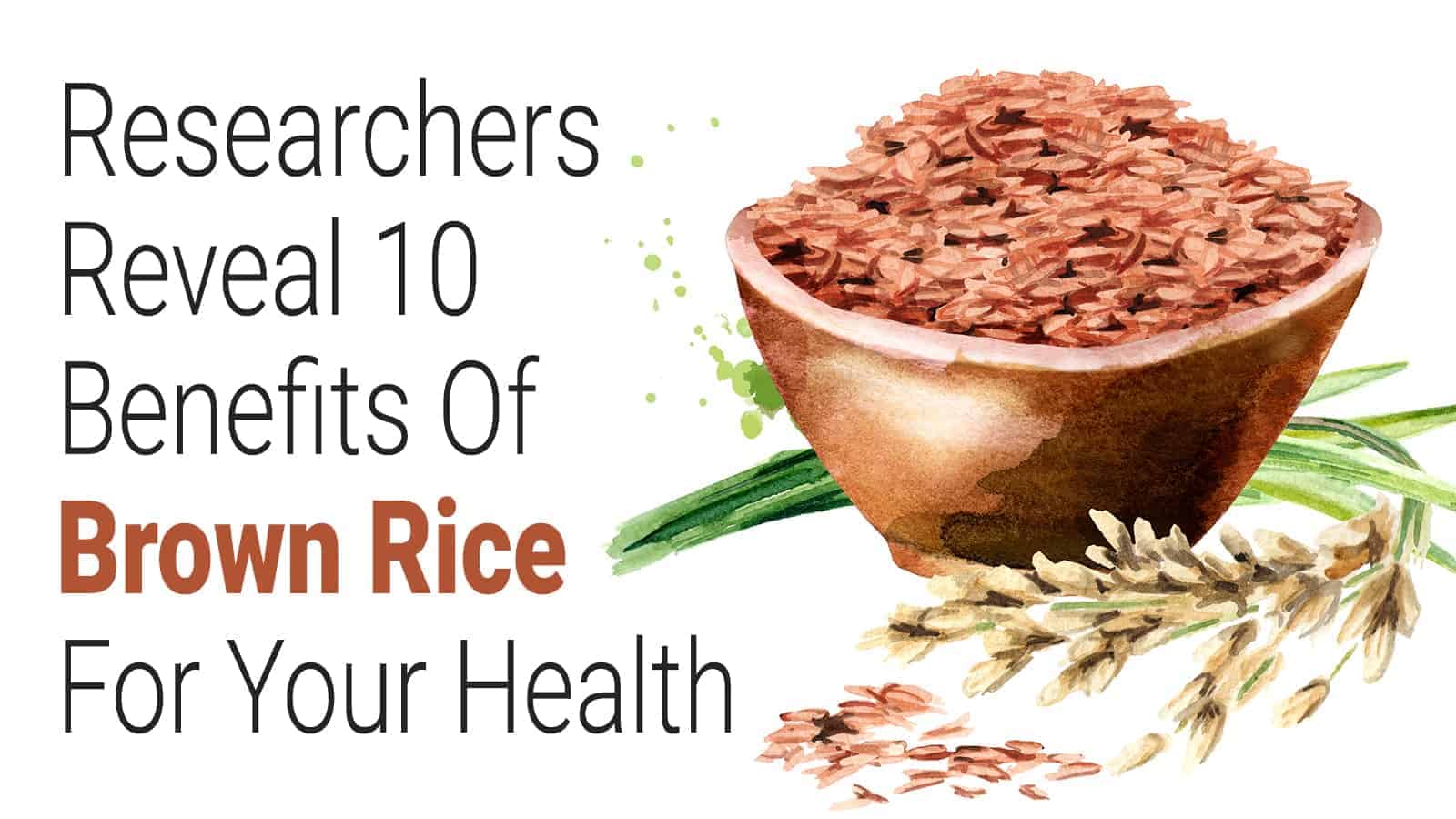Brown rice is a type of food commonly related to a healthy lifestyle. The food is deemed a whole grain since it is not as processed as white rice that has its germ, bran, and hull extracted.
When it comes to brown rice, only the hard, protective cover (the hull) has been removed while the nutrient-rich germ and bran remain. Hence, brown rice has nutrients like antioxidants, minerals, and vitamins not present in white rice.
Some people do not consume brown rice as a result of the increased popularity of diets low in carbs. Hence, this article will explain ten brown rice benefits.
1. Nutritious
Brown rice is simple food, but its nutritional profile is not. This rice has more to offer than white rice when it comes to nutrients. It might be similar to white rice in terms of carbohydrates and calorie content, but it is better in all the other categories.
This whole grain provides excellent amounts of calcium, potassium, folate, and riboflavin. Moreover, it is rich in manganese, which is crucial for numerous body processes like bone development, muscle contraction, blood sugar regulation, nerve function, and wound healing.
If you are deficient in manganese, you face higher risks of metabolic syndrome, low fertility, impaired growth, and bone demineralization. Just a cup of this rice will fulfill almost all your daily required intake of this mineral.
In addition to being an exceptional source of minerals and vitamins, the rice offers potent plant compounds too. For instance, it has flavonoids and phenols that safeguard your body against oxidative stress, which is linked to numerous health conditions like heart disease, premature aging, and particular cancer types.
The antioxidants present in the rice help prevent cell injury that results from unstable molecules referred to as free radicals; they also minimize inflammation in the body. According to research, the antioxidants in rice might cause the low prevalence of particular chronic conditions in global regions where this rice type serves as a staple food.
2. Reduced Risk of Colon Cancer
Diets loaded with fiber are linked to a reduced risk of getting colon cancer. However, brown rice is more efficient since it is rich in selenium.
Selenium is a mineral that is involved with numerous metabolic processes such as breaking down toxins and hormones. Moreover, the mineral starts the repair of ruined DNA, as well as prevents cancer cell growth and initiates the destruction of such cells.
3. Weight Loss
Consuming brown rice instead of refined grains can assist in weight loss. Refined grains like white pasta, white rice, and white bread don’t have fiber and other nutrients present in whole grains.
For instance, 158 grams of brown rice has 3.5 grams of fiber, while a similar quantity of white rice has one gram of fiber. Fiber helps you feel fuller for an extended period. Hence, fiber-rich foods will assist you in consuming fewer calories in general.
According to research, individuals who consume more whole grains such as brown rice weigh less than those who eat fewer whole grains. More studies have revealed that people who consume more fiber have a 49 percent lower likelihood of significant weight gain than those who consume less fiber.
Moreover, consuming brown rice instead of white rice will help you reduce belly fat. People who eat brown rice normally experience a great reduction in CRP (an inflammation marker) and blood pressure.
4. Prevents Constipation
Brown rice is full of fiber, which is mostly insoluble. Insoluble fiber is normally linked to improvements in intestinal mortality as well as the addition of bulk to waste.
Therefore, eating brown rice assists in preventing constipation. White rice cannot have the same effect on constipation since the fiber-rich outer layer has been eliminated. This is one of the most crucial brown rice benefits since constipation is a prevalent issue that many people ignore.
5. Better Heart Health
Without any doubt, one of the top brown rice benefits is a healthy heart. It is full of essential compounds and fiber that can assist in minimizing heart disease risk. According to a study, participants who consumed plenty of dietary fiber had a 24-59 percent lower chance of developing cancer, heart disease, and respiratory diseases.
Other studies show that individuals who consume plenty of whole grains such as brown rice have a 21 percent lower risk of getting coronary heart disease compared to people who eat fewer whole grains. In addition to being an excellent fiber source, brown rice also has compounds called lignans that can assist in the reduction of risk factors of heart disease.
Diets rich in foods that are full of lignans like whole grains, nuts, sesame seeds, and flaxseeds have been linked to minimal cholesterol, reduced artery fitness, and lower blood pressure. Even more, brown rice is rich in magnesium that assists in maintaining heart health.
According to research, increasing the consumption of dietary fiber can reduce the risk of stroke, all-cause mortality, and heart failure by 7-22 percent. Other studies show that a daily intake of 100 mg of dietary magnesium minimizes the risk of heart disease in females by 24-25 percent.
6. Optimal Energy Production
Consumption of high-quality carbs is an ideal way to get energy supply. But you also need to ensure the proper conversion of those carbs to energy. Brown rice has manganese, which is essential in the energy production process.
Manganese assists in making sure that energy is produced from the carbs and the proteins that you consume. The mineral is also critical to the production of fatty acids that ultimately assist in regulating cholesterol production and leveling body hormones. Hence, consuming brown rice can assist in the increase in levels of testosterone.
7. Ideal for People with Diabetes
Decreasing the intake of carbohydrates and picking healthier alternatives is crucial for control of blood sugar. Since starch has the most significant effect on blood sugar, individuals who have diabetes can minimize insulin and blood sugar spikes by consuming fewer refined grains such as white rice.
Eating brown rice instead of white rice can benefit people who have diabetes, in numerous ways. Research shows that individuals who consume brown-rice regularly experience a critical reduction in post-meal blood sugar as well as hemoglobin A1c, a blood sugar control marker, compared to the control group.
Brown-rice has a minimal glycemic index in comparison to white rice; this means that it undergoes slower digestion and has minimal effect on blood sugar. Consuming foods that have a minimal glycemic index can assist diabetic people in controlling their blood sugar.
Numerous studies reveal that foods that have a greater glycemic index increase the levels of blood sugar, ghrelin, and insulin. Ghrelin is a hunger-driving hormone; reducing its levels can help diabetic patients to control their hunger; reducing overeating can help control blood sugar levels.
Moreover, consuming brown rice instead of white rice can minimize type 2 diabetes risk if you don’t have the condition. Research shows that replacing 50 grams of white rice with a similar amount of brown rice can assist in reducing the type 2 diabetes risk by 16 percent.
8. Improved Quality of Sleep
Numerous factors are involved in sleeplessness. However, a not-so-popular and common contributing factor is a hormone called melatonin. Brown rice naturally has the hormone, which assists in the promotion of deep, restful sleep.
It is also critical to sleep without lights, which inhibit the hormone. Brown rice also has B vitamins that assist with the sleep cycle and metabolism.
9. Gluten-Free
Gluten is a protein present in grains such as rye, barley, and wheat. Nowadays, more and more individuals are adopting diets that are free from gluten for many reasons. Some individuals are intolerant or allergic to gluten and face severe or mild reactions when they eat it such as vomiting, bloating, stomach pain, and diarrhea.
Moreover, individuals with particular autoimmune diseases normally benefit from a diet free from gluten. These factors have resulted in a decreased demand for foods with gluten. Fortunately, brown rice naturally lacks this problematic protein, which makes it a safe option for those who are allergic to gluten.
Brown rice is not like highly processed gluten-free foods; it is a whole grain full of essential minerals and nutrients. You can also find other gluten-free foods, such as pasta and crackers, made from this form of rice.
10. Prevents Neuro-Degenerative Conditions
We have generally accepted the fact that the brain experiences varying levels of breakdown during advanced age. But some individuals face accelerated breakdown that leads to conditions such as Parkinson’s and Alzheimer’s.
However, brown rice has GABA, a compound linked to a decreased risk of these conditions that also increases the levels of antioxidants in the body in order to offset the conditions.
Conclusion
If you are looking to change your lifestyle to a healthy one, then including brown rice in your diet is a great start. You will not only have a healthy heart, but you will also reduce your chances of suffering from diabetes. You will sleep better, have more energy, and have a lower risk of neuro-degenerative conditions, along with other brown rice benefits. But also combine it with other healthy foods to make sure you enjoy complete brown rice benefits.
The good thing about this food is that it is easy to cook. You only need to boil it for fifteen minutes and serve with a stew of vegetables or proteins like grains and animal products. Hence, by spending a few minutes in preparation every week, you can prepare brown rice for weekly lunches that you can then augment with a variety of stews and sauces.














 Community
Community

